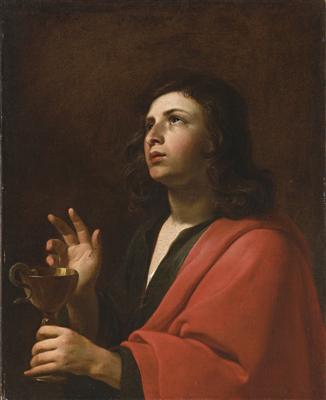Giusto Fiammingo

(active in Rome 1615–1625)
Saint John the Evangelist,
oil on canvas, 75 x 60.5 cm, framed
Provenance:
Dumousset-Deburaux, Paris 7 December 1989, lot 177 (as Nicolas Tournier); with Galerie Tassel, Paris 1994;
Christie’s London 7 July 1995, lot 311 (as Nicolas Tournier);
with Galerie Feigen, New York (as Nicolas Tournier);
European private collection.
Literature:
A.Hemery, Nicolas Tournier 1590-1639. Un peintre caravagesque, exhibition catalogue, Toulouse 2001, p. 175, fig. 59 (as Anonyme nordique);
G. Papi, Su Giusto Fiammingo, “Paragone”, LIII, maggio 2002, 43, p. 31, no. 18, p. 32, tav. 22 and II (as Giusto Fiammingo).
This painting has been identified as a work by Giusto Fiammingo by Gianni Papi (Papi 2002), who publishes it in an essay where he reassembles and extends the corpus of painter´s works.
The present work had been previously attributed to the French painter Nicolas Tournier since its appearance on the French market in 1989 and then appeared with the same attribution in London (Christie´s , 7 July 1995, lot 311) and New York (Feigen Gallery). However, in 2001 the attribution to Tournier was refused in the catalogue of the exhibition curated by Hemery, who prefered to ascribe it to an anonymous northern painter.
According to Papi, the figure of Saint John the Evangelist in the present painting closely resembles the series of the Pallavicini Angels with the symbols of the Passion of Christ (Rome, Galleria Pallavicini) and in particular the one depicting the Angel holding the spear and the sponge. The outline of the hands and the drapery in the two paintings are very similar, and the facial type appears as nearly identical. In his opinion the present painting might be the earlier in the corpus of known works of the artist, and can be dated at the beginning of the third decade of the 17th century, when the artist was particularly influenced by Vouet’s examples as La Maddalena (Quirinale Palace, Rome) and an Allegory (Pinacoteca Capitolina, Rome).
The identity of the artist, active in the Rome in the second and third decade of the 17th century, still remains unclear. The painter is mentioned as “Giusto Fiammingo” in the inventory of the marquis Vincenzo Giustiniani’s properties (1638), where two paintings are registered under his name: the Death of Socrate’s (former Kaiser Friederich Museum,Berlin, destroyed) and the Escape of the young naked boy (Rob Smeets collection). Federico Zeri, following Roberto Longhi, put together a number of works with similar characteristics referring them to the anonymous “Master of the Pallavicini Angels” (see F. Zeri, La Galleria Pallavicini a Roma, Firenze 1959, pp. 71-72).. The following attempts in identifying the anonymous painter with one of the several young Flemish artists in Rome such as Joos de Pape (Bodart 1970) or Jean Ducamps has yet to find unanimous acceptance amongst scholars.
17.04.2013 - 18:00
- Estimate:
-
EUR 25,000.- to EUR 35,000.-
Giusto Fiammingo
(active in Rome 1615–1625)
Saint John the Evangelist,
oil on canvas, 75 x 60.5 cm, framed
Provenance:
Dumousset-Deburaux, Paris 7 December 1989, lot 177 (as Nicolas Tournier); with Galerie Tassel, Paris 1994;
Christie’s London 7 July 1995, lot 311 (as Nicolas Tournier);
with Galerie Feigen, New York (as Nicolas Tournier);
European private collection.
Literature:
A.Hemery, Nicolas Tournier 1590-1639. Un peintre caravagesque, exhibition catalogue, Toulouse 2001, p. 175, fig. 59 (as Anonyme nordique);
G. Papi, Su Giusto Fiammingo, “Paragone”, LIII, maggio 2002, 43, p. 31, no. 18, p. 32, tav. 22 and II (as Giusto Fiammingo).
This painting has been identified as a work by Giusto Fiammingo by Gianni Papi (Papi 2002), who publishes it in an essay where he reassembles and extends the corpus of painter´s works.
The present work had been previously attributed to the French painter Nicolas Tournier since its appearance on the French market in 1989 and then appeared with the same attribution in London (Christie´s , 7 July 1995, lot 311) and New York (Feigen Gallery). However, in 2001 the attribution to Tournier was refused in the catalogue of the exhibition curated by Hemery, who prefered to ascribe it to an anonymous northern painter.
According to Papi, the figure of Saint John the Evangelist in the present painting closely resembles the series of the Pallavicini Angels with the symbols of the Passion of Christ (Rome, Galleria Pallavicini) and in particular the one depicting the Angel holding the spear and the sponge. The outline of the hands and the drapery in the two paintings are very similar, and the facial type appears as nearly identical. In his opinion the present painting might be the earlier in the corpus of known works of the artist, and can be dated at the beginning of the third decade of the 17th century, when the artist was particularly influenced by Vouet’s examples as La Maddalena (Quirinale Palace, Rome) and an Allegory (Pinacoteca Capitolina, Rome).
The identity of the artist, active in the Rome in the second and third decade of the 17th century, still remains unclear. The painter is mentioned as “Giusto Fiammingo” in the inventory of the marquis Vincenzo Giustiniani’s properties (1638), where two paintings are registered under his name: the Death of Socrate’s (former Kaiser Friederich Museum,Berlin, destroyed) and the Escape of the young naked boy (Rob Smeets collection). Federico Zeri, following Roberto Longhi, put together a number of works with similar characteristics referring them to the anonymous “Master of the Pallavicini Angels” (see F. Zeri, La Galleria Pallavicini a Roma, Firenze 1959, pp. 71-72).. The following attempts in identifying the anonymous painter with one of the several young Flemish artists in Rome such as Joos de Pape (Bodart 1970) or Jean Ducamps has yet to find unanimous acceptance amongst scholars.
|
Buyers hotline
Mon.-Fri.: 10.00am - 5.00pm
old.masters@dorotheum.at +43 1 515 60 403 |
| Auction: | Old Master Paintings |
| Auction type: | Saleroom auction |
| Date: | 17.04.2013 - 18:00 |
| Location: | Vienna | Palais Dorotheum |
| Exhibition: | 06.04. - 17.04.2013 |
